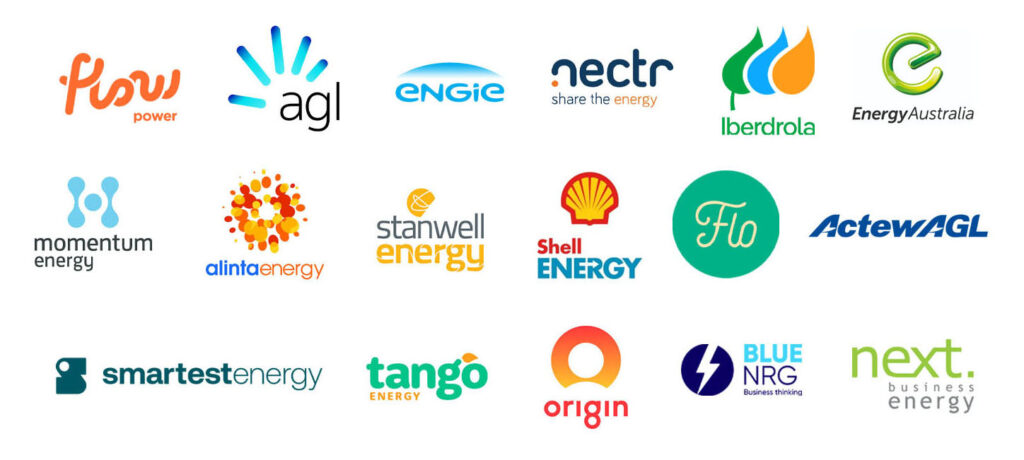Australia stands at the crossroads of a monumental energy transformation, transitioning from a reliance on coal-fired generation to embracing renewable energy sources with the hopes of attaining a Net Zero economy.
The Australian Energy Market Operator (AEMO) has recently released its Draft 2024 Integrated System Plan (ISP), outlining a strategic roadmap for the National Electricity Market (NEM).
This comprehensive plan aims to ensure a secure, reliable, and affordable energy supply, aligning with the nation’s commitment to achieving a net-zero economy by 2050.
Key Components of the Draft 2024 ISP
- Current Energy Landscape
The energy transition is already in progress, with renewables accounting for nearly 40% of total energy delivered through the NEM in the first half of 2023.
Coal retirements are outpacing initial announcements, with forecasts indicating that about 90% of the NEM’s coal fleet may retire before 2035.
- Optimal Development Path (ODP)
AEMO’s modelling approach identifies the ODP, emphasizing the needed balance between generation, firming, and transmission to ensure reliability, security, and long-term consumer benefits.
The ODP calls for urgent investments in renewable generation, firming technologies, and transmission, aiming to triple grid-scale variable renewable energy by 2030 and increase it sevenfold by 2050.
- Transmission Investments
Transmission projects are crucial for connecting diverse renewable energy sources to demand centres, enhancing grid reliability, and fostering regional expertise.
The ODP recommends a significant transmission network expansion, with close to 10,000 km needed by 2050 under the Step Change and Progressive Change scenarios.
- Benefits of the ODP
The selected ODP represents a comprehensive strategy, guiding capital investments, avoiding $17 billion in additional costs to consumers, and connecting emerging renewable areas to urban and industrial centres.
Annualised capital costs for generation, firming, storage, and transmission infrastructure in the ODP amount to $121 billion (Step Change scenario to 2050).
- Risks and Challenges:
Delays in ODP implementation increase the risk of interruptions and higher costs.
Risks include uncertainties in infrastructure investment, early coal retirements, market readiness for 100% renewables, integration of consumer energy resources, and challenges in securing social acceptance and supply chains.
The Urgency of Australia’s Energy Transition
Shifting Tides: From Coal to Firmed Renewables
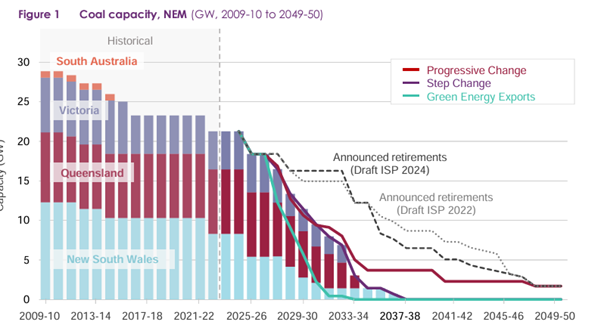
The ISP emphasises the urgency of the ongoing energy transition, highlighting the retirement of coal-fired generators and the emergence of firmed renewables as the most cost-effective solution for meeting electricity demands.
With coal’s decline, renewable energy, supported by robust transmission and storage infrastructure, takes centre stage in powering homes and businesses across Australia.
Government Targets and the 2050 Net Zero Economy Vision
Governments at various levels have set ambitious targets, aiming for a net-zero economy by 2050.
The Federal Government envisions a 43% reduction in 2005-level emissions by 2030, with 82% of electricity in the National Electricity Market (NEM) sourced from renewables.
The energy transition, already in full swing, represents the most significant transformation in the NEM’s 25-year history.
AEMO’s Integrated System Plan: Navigating the Transition
Published biennially, AEMO’s Integrated System Plan is a critical guide for the NEM’s transition.
The Draft 2024 ISP, a milestone in this journey, calls for urgent investments in generation, firming, and transmission.
It reflects extensive consultations with stakeholders, ranging from consumer representatives to industry bodies, ensuring a comprehensive and inclusive approach to the energy transition.
The Current State of Australia’s Energy Transition
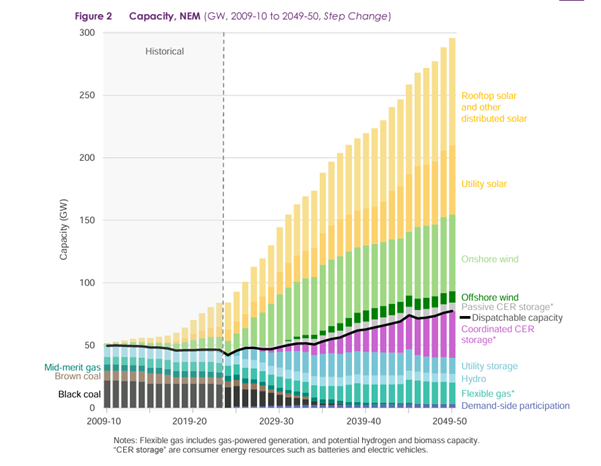
Breaking Records: Renewable Generation’s Ascent
Australia’s energy transition is already making waves, achieving record-breaking levels of renewable generation.
In the first half of 2023, renewables accounted for nearly 40% of the total energy delivered through the NEM, reaching a remarkable 72.1% on October 24, 2023.
Rooftop solar outpaced grid-scale solar, wind, hydro, and gas in contributing electricity to the grid.
Government Initiatives: A Unified Push for Renewables
All NEM governments are actively supporting the transition.
The Federal Government’s Capacity Investment Scheme, New South Wales’ Electricity Infrastructure Roadmap and Renewable Energy Zones (REZs), Queensland’s Super Grid and pumped hydro energy storage, South Australia’s Hydrogen Jobs Plan, and Tasmania’s renewable energy targets showcase a unified commitment to embracing renewables.
Economic Opportunities and Job Growth
The transition to renewables presents undeniable economic benefits.
Lower-cost, lower-emission renewables offer homes and businesses stable electricity prices, insulating them from international price fluctuations.
AEMO forecasts over 70,000 jobs needed to build and maintain new infrastructure over the next two decades, promising economic growth and employment opportunities.
The Optimal Development Path: AEMO’s Strategic Vision
A Roadmap to Completion: ISP’s Optimal Development Path
AEMO’s ISP employs an optimal development path (ODP) approach to determine the ideal generation, storage, and transmission mix for the NEM’s future.
The ISP models over 1,000 potential development paths, narrowing them down to 18 candidate paths aligned with three future scenarios:
- Step Change
- Progressive Change
- Green Energy Exports
Step Change Scenario: A Likely Path Forward
After extensive consultation, AEMO assigns a likelihood of 43% to the Step Change scenario, making it the ISP’s most probable future. This scenario foresees the retirement of about 90% of the current 21 GW of coal capacity by 2034-35 and complete retirement before 2040, outpacing previous announcements. The ISP’s leading candidate paths undergo rigorous testing against changes in scenario assumptions to ensure resilience and cost-effectiveness.
Generation and Storage Investments in the ODP
With coal declining, the ODP emphasises the pivotal role of renewable energy, supported by transmission and storage. Low-cost renewables, including wind, solar, and hydro, are set to dominate the landscape.
Firming technologies such as pumped hydro, batteries, and gas-powered generation will mitigate variability, ensuring a reliable energy supply.
The ODP also envisions a significant increase in rooftop solar capacity and dispatchable storage.
Transmission Investments: Connecting the Dots
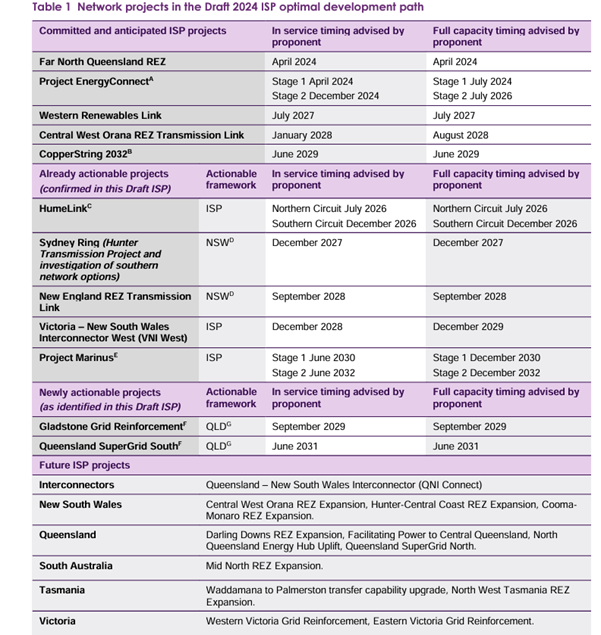
Transmission infrastructure is the foundation of the energy transition, connecting diverse sources of generation and storage to urban centres and industries.
The ODP identifies the need for close to 10,000 km of new transmission by 2050, emphasising the importance of completing actionable projects, advancing future projects, and delivering urgently needed transmission enhancements.
Benefits of the Optimal Development Path
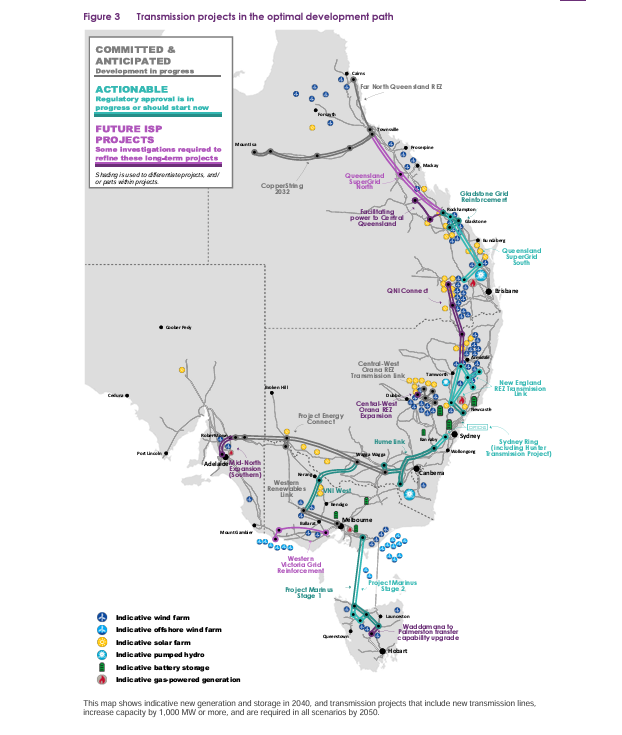
Guiding Capital Investment: A $2 Trillion Economy Sustained
The ODP guides capital investment in essential electricity infrastructure, supporting Australia’s $2 trillion annual economy.
The ISP estimates an annualised capital cost of $121 billion (Step Change scenario to 2050), with transmission projects accounting for 13.5% of the total.
The ODP avoids $17 billion in additional costs and connects renewable generation to regional industries, fostering economic growth.
Job Creation and Economic Opportunities
The energy transition is not just a technological shift but a driver of economic opportunities and job creation.
The NEM is projected to require over 70,000 skilled workers by 2050, spanning various disciplines beyond engineering.
This workforce demand surge underscores the energy transition’s transformative impact on Australia’s employment landscape.
Net Market Benefits: A Win-Win Scenario
Investing in the ODP ensures a reliable and secure energy supply and delivers consumers a net market benefit of $17 billion.
This benefit, calculated in present value terms, underscores the economic wisdom of including transmission in capital investment.
Risks to Delivery and the Energy Transition
Uncertainty in Infrastructure Investment
Despite progress in the energy transition, uncertainty in infrastructure investment still needs to be addressed.
Delays in project approval, community opposition, and regulatory hurdles can impede the prompt development of critical infrastructure, jeopardising the transition’s success.
Addressing these challenges requires a joint approach involving governments, industry stakeholders, and local communities.
Policy and Regulatory Stability
Policy and regulatory stability are vital for attracting the necessary investments to drive the energy transition.
The ISP underscores the need for clear, stable policies that give investors confidence and certainty.
Regulatory frameworks should align with the transition’s pace, ensuring a smooth, predictable path toward a cleaner, more sustainable energy future.
Climate Change and Extreme Weather Events
Climate change threatens energy infrastructure, with extreme weather events becoming more frequent and severe.
The ISP recognises the need for climate-resilient infrastructure planning, emphasising adaptive strategies to safeguard against potential risks.
Integrating climate considerations into the planning and development of energy projects is crucial for long-term resilience.
Navigating the Road Ahead
Australia’s energy transition is at a critical juncture, with AEMO’s Draft 2024 Integrated System Plan supplying a comprehensive roadmap for navigating the road ahead. The ISP’s optimal development path centred on renewables, storage, and transmission, positions Australia to achieve its net-zero ambitions by 2050.
As the nation stands on the brink of a historic transformation, collaboration, innovation, and sustained commitment will be the driving forces to ensure a brighter, more sustainable energy future for the coming generations.
To read the entire text of AEMO Draft 2024 Integrated System Plan, click here.
—
Doing your part in the transition to a Net Zero Economy
As the country progresses in its march towards a net zero economy to ensure a more sustainable energy future, businesses are also encouraged to start taking their steps towards compliance.
Leading Edge Energy can provide net-zero compliance assistance to businesses who want to manage their energy consumption and reduce their emissions in order to meet the objectives of Net Zero 2050. Get in touch with our energy management consultants for an obligation-free consultation – call us at 1300-852-770 or send an email to info@leadingedgeenergy.com.au.
To learn more about how your business can navigate the energy transition and how Leading Edge Energy can guide you through the process, visit our Net Zero service page here.
We source, analyse, compare and rank commercial, industrial and multisite energy quotes. Obligation Free.
Chat with one of our experienced consultants today and get the insights your business needs to help manage the risks associated with volatile electricity and natural gas markets. Our energy procurement service is obligation-free and provides a time-saving way of securing lower energy rates from our panel of energy retailers.
